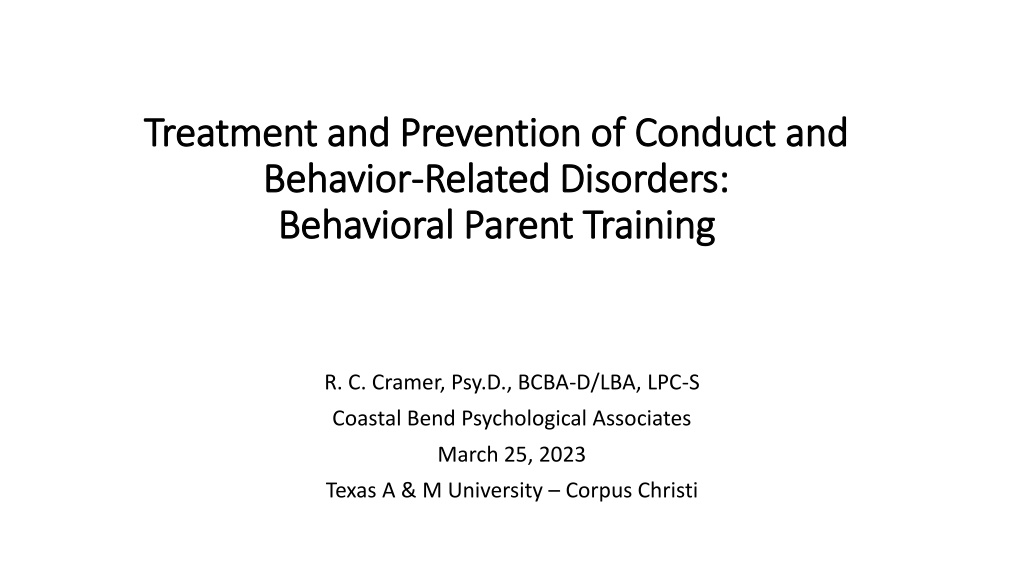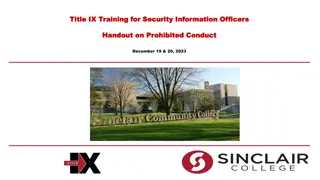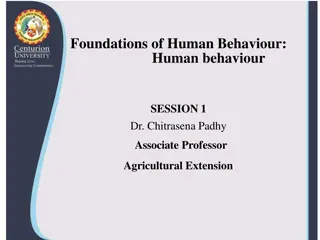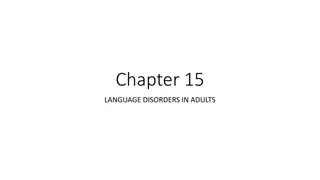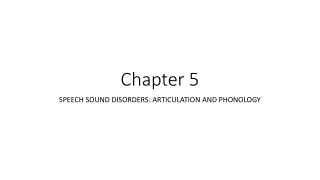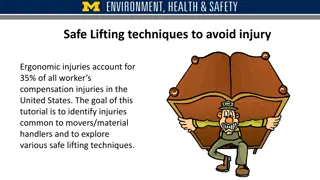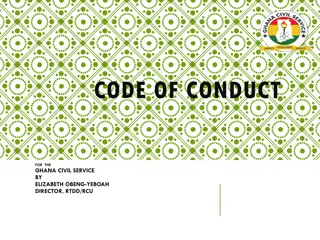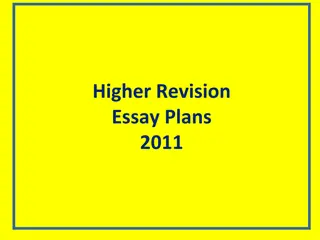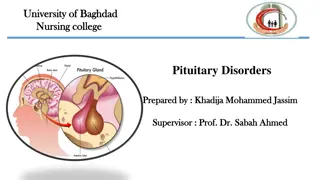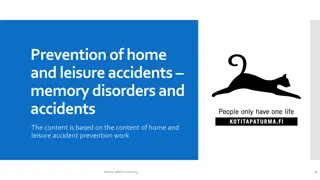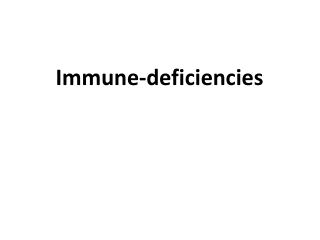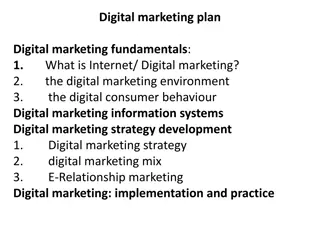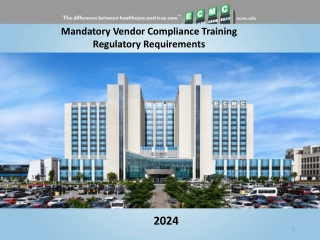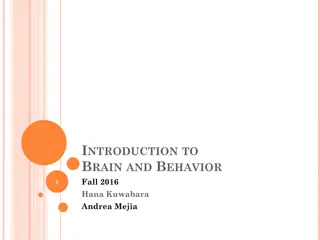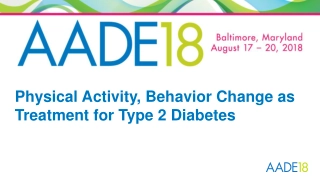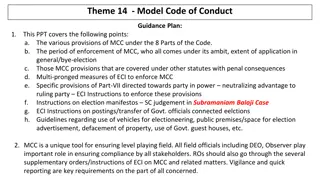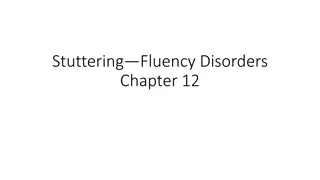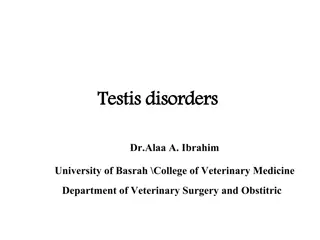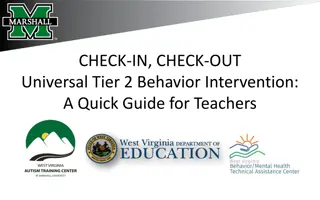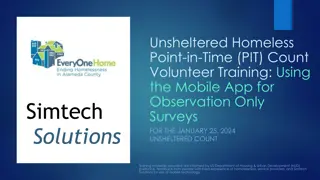Understanding Parent Training for Conduct and Behavior Disorders
Explore the significance of parent training in treating and preventing conduct and behavior-related disorders. Learn about evidence-based programs, applied behavior analysis, and the role of parents in addressing behavioral issues effectively.
Download Presentation
Please find below an Image/Link to download the presentation.
The content on the website is provided AS IS for your information and personal use only. It may not be sold, licensed, or shared on other websites without obtaining consent from the author. Download presentation by click this link. If you encounter any issues during the download, it is possible that the publisher has removed the file from their server.
Presentation Transcript
Treatment and Prevention of Conduct and Treatment and Prevention of Conduct and Behavior Behavior- -Related Disorders: Related Disorders: Behavioral Parent Training Behavioral Parent Training R. C. Cramer, Psy.D., BCBA-D/LBA, LPC-S Coastal Bend Psychological Associates March 25, 2023 Texas A & M University Corpus Christi
Introduction Introduction Housekeeping Info + Who are you? Who am I?
Outline Outline Conduct and Behavior-Related Disorders Symptoms, Onset, Prevalence, Causative Agents, Risk Factors, Outlook, and Prognosis of these disorders Review Treatment Options Parent Training - Treatment and Prevention History of Parent Training Evidence-Based & Empirically-Supported Programs Applied Behavior Analysis Converting Research into Practice
Course Objectives Course Objectives Participants will be able to state and discuss Conduct and Behavior- Related Disorders Participants will be able to state and discuss commonalities amongst Evidence-Based & Empirically-Supported Programs Participants will be able to state and discuss the use of a parent training framework from a behavioral perspective
Conduct and Behavior Conduct and Behavior- -Related Disorders Related Disorders DSM-5 Category - Disruptive, Impulse-Control, and Conduct Disorders Oppositional Defiant Disorder Intermittent Explosive Disorder Pyromania Kleptomania Conduct Disorder Antisocial Personality Disorder (commentary)
Other Behavior Other Behavior- -Related Disorders Related Disorders (that a true behaviorist would consider ) (that a true behaviorist would consider ) Attention-Deficit/Hyperactivity Disorder Obsessive-Compulsive and Related Disorders Feeding and Eating Disorders Elimination Disorders Sleep-Wake Disorders Substance-Related and Addictive Disorders EVERYTHING IS A BEHAVIOR!!!
Oppositional Defiant Disorder Oppositional Defiant Disorder A. A pattern of angry/irritable mood, argumentative/defiant behavior, or vindictiveness lasting at least 6 months as evidenced by at least four symptoms of the following categories, and exhibited during interaction with at least one individual who is not a sibling: Angry/Irritable Mood 1. Often loses temper 2. Is often touchy or easily annoyed 3. Is often angry and resentful Argumentative/Defiant Behavior 4. Often argues with authority figures or, for children and adolescents, with adults 5. Often actively defies or refuses to comply with requests from authority figures or with rules 6. Often deliberately annoys others 7. Often blames others for his or her mistakes or misbehavior Vindictiveness 8. Has been spiteful or vindictive at least twice within the past 6 months. Note: The persistence and frequency of these behaviors should be used to distinguish a behavior that is within normal limits from a behavior that is symptomatic. For children younger than 5 years, the behavior should occur on most days for a period of at least 6 months unless otherwise noted (Criterion AB). For individuals 5 years or older, the behavior should occur at least once per week for at least 6 months. Unless otherwise noted (Criterion AB). While these frequency criteria provide guidance on a minimal level of frequency to define symptoms, other factors should also be considered, such as whether the frequency and intensity of the behaviors are outside a range that is normative for the individual s developmental level, gender, and culture.
Oppositional Defiant Disorder (Continued) Oppositional Defiant Disorder (Continued) B. The disturbance in behavior is associated with distress in the individual or others in his or her immediate social context (e.g., family, peer group, work colleagues) or it impacts negatively on social, educational, occupational, or other important areas of functioning, C. The behavior does not occur exclusively during the course of a psychotic, substance use, depressive, or bipolar disorder. Also the criteria are not met for disruptive mood dysregulation disorder. Specify current severity: Mild: Symptoms are confined to only one setting (e.g., at home, at school, at work, with peers). Moderate: Some symptoms are present in at least two settings Severe: Some symptoms are present in three or more settings.
Intermittent Explosive Disorder Intermittent Explosive Disorder A. Recurrent behavioral outburst representing a failure to control aggressive impulses as manifested by either of the following: 1. Verbal aggression (e.g., temper tantrums, tirades, verbal arguments or fights) or physical aggression toward property, animals, or other individuals, occurring twice weekly, on average, for a period of 3 months. The physical aggression does not result in damage or destruction of property and does not result in physical injury to animals or other individuals. 2. Three behavioral outbursts involving damage or destruction of property and/or physical assault involving physical injury against animals or other individuals occurring within a 12-month period. B. The magnitude of aggressiveness expressed during the recurrent outbursts is grossly out of proportion to the provocation or to any precipitating psychosocial stressors.
Intermittent Explosive Disorder (Continued) Intermittent Explosive Disorder (Continued) C. The recurrent aggressive outbursts are not premeditated (i.e., they are impulsive and/or anger- based) and are not committed to achieve some tangible objective (e.g., money, power, intimidation). D. The recurrent aggressive outbursts cause either marked distress in the individual or impairment in occupational or interpersonal functioning, or are associated with financial or legal consequences. E. Chronological age is at least 6 years (or equivalent developmental level). F. The recurrent aggressive outbursts are not better explained by another mental disorder (e.g., Major Depressive Disorder, Bipolar Disorder, Disruptive Mood Dysregulation Disorder, a Psychotic Disorder, Antisocial Personality Disorder, Borderline Personality Disorder) and are not attributable to another medical condition (e.g., head trauma, Alzheimer s disease) or to the physiological effects of a substance (e.g., a drug of abuse, a medication). For children ages 6 to 18 years, aggressive behavior that occurs as part of an Adjustment Disorder should not be considered for this diagnosis. Note: This diagnosis can be made in addition to the diagnosis of ADHD, Conduct Disorder, ODD, or ASD when recurrent impulsive aggressive outbursts are in excess of those usually seen in these disorders and warrant independent clinical attention.
Pyromania Pyromania A.Deliberate and purposeful fire setting on more than one occasion. B.Tension or affective arousal before the act. C.Fascination with, interest in, curiosity about, or attraction to fire and its situational contexts (e.g., paraphernalia, uses, consequences). D.Pleasure, gratification, or relief when setting fires or when witnessing or participating in their aftermath. E.The fire setting is not done for monetary gain, as an expression of sociopolitical ideology, to conceal criminal activity, to express anger or vengeance, to improve one s living circumstances, in response to a delusion or hallucination, or as a result of impaired judgment (e.g., major neurocognitive disorder, intellectual disability, substance intoxication). F.The fire setting is not better explained by conduct disorder, a manic episode, or antisocial personality disorder.
Kleptomania Kleptomania A. Recurrent failure to resist impulses to steal objects that are not needed for personal use or for their monetary value. B. Increasing sense of tension immediately before committing the theft. C. Pleasure, gratification, or relief at the time of committing the theft. D. The stealing is not committed to express anger or vengeance and is not in response to a delusion or a hallucination. E. The stealing is not better explained by Conduct Disorder, a manic episode, or Antisocial Personality Disorder.
Conduct Disorder * Conduct Disorder * A. A repetitive and persistent pattern of behavior in which the basic rights of others or major age- appropriate societal norms or rules are violated, as manifested by the presence of at least three of the following 15 criteria in the past 12 months from any of the categories below, with at least one criterion present in the past 6 months: Aggression to People and Animals 1. Often bullies, threatens, or intimidates others. 2. Often initiates physical fights. 3. Has used a weapon that can cause serious physical harm to others (e.g., a bat, brick, broken bottle, knife, gun). 4. Has been physically cruel to people. 5. Has been physically cruel to animals. 6. Has stolen while confronting a victim (e.g., mugging, purse snatching, extortion, armed robbery). 7. Has forced someone into sexual activity.
Conduct Disorder (Continued) Conduct Disorder (Continued) Destruction of Property 8. Has deliberately engaged in fire setting with the intention of causing serious damage. 9. Has deliberately destroyed others property (other than by fire setting). Deceitfulness or Theft 10. Has broken into someone else s house, building, or car. 11. Often lies to obtain goods or favors or to avoid obligations (i.e., cons others). 12. Has stolen items of nontrivial value without confronting a victim (e.g., shoplifting, but without breaking and entering; forgery). Serious Violations of Rules 13. Often stays out at night despite parental prohibitions, beginning before age 13 years. 14. Has run away from home overnight at least twice while living in the parental or parental surrogate home, or once without returning for a lengthy period. 15. Is often truant from school, beginning before age 13 years
Conduct Disorder (Continued) Conduct Disorder (Continued) B. The disturbance in behavior causes clinically significant impairment in social, academic, or occupational functioning. C. If the individual is age 18 years or older, criteria are not met for Antisocial Personality Disorder. Specify whether: 312.81 (F91.1) Childhood-onset type: Individuals show at least one symptom characteristic of conduct disorder prior to age 10 years. 312.82 (F91.2) Adolescent-onset type: Individuals show no symptom characteristic of conduct disorder prior to age 10 years. 312.89 (F91.9) Unspecified onset: Criteria for a diagnosis of conduct disorder are met, but there is not enough information available to determine whether the onset of the first symptom was before or after age 10 years.
Conduct Disorder (Continued) Conduct Disorder (Continued) Specify if: With limited prosocial emotions: To qualify for this specifier, an individual must have displayed at least two of the following characteristics persistently over at least 12 months and in multiple relationships and settings. These characteristics reflect the individual s typical pattern of interpersonal and emotional functioning over this period and not just occasional occurrences in some situations. Thus, to assess the criteria for the specifier, multiple information sources are necessary. In addition to the individual s self-report, it is necessary to consider reports by others who have known the individual for extended periods of time (e.g., parents, teachers, co-workers, extended family members, peers). Lack of remorse or guilt: Does not feel bad or guilty when he or she does something wrong (exclude remorse when expressed only when caught and/or facing punishment). The individual shows a general lack of concern about the negative consequences of his or her actions. For example, the individual is not remorseful after hurting someone or does not care about the consequences of breaking rules. Callous lack of empathy: Disregards and is unconcerned about the feelings of others. The individual is described as cold and uncaring. The person appears more concerned about the effects of his or her actions on himself or herself, rather than their effects on others, even when they result in substantial harm to others. Unconcerned about performance: Does not show concern about poor/problematic performance at school, at work, or in other important activities. The individual does not put forth the effort necessary to perform well, even when expectations are clear, and typically blames others for his or her poor performance. Shallow or deficient affect: Does not express feelings or show emotions to others, except in ways that seem shallow, insincere, or superficial (e.g., actions contradict the emotion displayed; can turn emotions on or off quickly) or when emotional expressions are used for gain (e.g., emotions displayed to manipulate or intimidate others)
Conduct Disorder (Continued) Conduct Disorder (Continued) Specify current severity: Mild: Few if any conduct problems in excess of those required to make the diagnosis are present, and conduct problems cause relatively minor harm to others (e.g., lying, truancy, staying out after dark without permission, other rule breaking). Moderate: The number of conduct problems and the effect on others intermediate between those specified in mild and those in severe (e.g., stealing without confronting a victim, vandalism). Severe: Many conduct problems in excess of those required to make the diagnosis are present, or conduct problems cause considerable harm to others (e.g., forced sex, physical cruelty, use of a weapon, stealing while confronting a victim, breaking and entering)
Onset Onset The DSM-5 notes that Conduct Disorder can appear as early as the preschool years, with ODD (Oppositional Defiant Disorder) a common premorbid condition, which may progress to Conduct Disorder. Middle childhood to middle adolescence is the time frame where Conduct Disorder symptoms are most apparent, and come to parental/educational/clinical attention. Rejection by more prosocial peers and association with delinquent peers with reinforcement of conduct disordered behaviors my occur (American Psychiatric Association, 2013). Theravive
Prevalence Prevalence According to the DSM-5, the annual prevalence of Conduct Disorder is 2% to 10%, with a median of 4%. It is more common in boys, or at least more apparent and more frequently diagnosed, due to boy's tendency to act out violently, while girls tend to act out in interpersonal relationships e.g., social rejection of disliked peers, non-confrontation of a victim through malicious postings on a social networking site (American Psychiatric Association, 2013). Theravive
Causative Agents & Risk Factors Causative Agents & Risk Factors What causes conduct disorder in a child? Experts believe that many factors play a role in Conduct Disorder. These are: Brain damage A traumatic event Genes Child abuse Past school failure Social problems Some children with Conduct Disorders seem to have a problem in the frontal lobe of the brain. This interferes with a child s ability to plan, stay away from harm, and learn from negative experiences. Some experts believe that a series of traumatic experiences occurs for a child to develop a conduct disorder. These experiences then often lead to depressed mood, behavior problems, and involvement in a deviant peer group.
Causative Agents & Risk Factors (Continued) Causative Agents & Risk Factors (Continued) A Conduct Disorder is more common in boys than in girls. It is also more likely to develop in children or teens who come from homes that are: Disadvantaged Dysfunctional Disorganized Children with these mental health problems are also more likely to have conduct disorder: Mood or anxiety disorders Posttraumatic Stress Disorder (PTSD) Substance Use Disorder Attention-Deficit/Hyperactivity Disorder (ADHD) Learning problems Children or teens who are considered to have a difficult temperament are more likely to develop behavior problems. Johns Hopkins
Causative Agents & Risk Factors (Continued) Causative Agents & Risk Factors (Continued) What causes Conduct Disorder? Researchers aren t sure what exactly causes Conduct Disorder (CD), but they think it s a complex combination of genetic/biological and environmental factors. Genetic/biological factors: Various studies show that certain characteristics of CD can be inherited, including antisocial behavior, impulsivity, temperament, aggression and insensitivity to punishment. High testosterone levels are associated with aggression. Traumatic brain injury, seizures, and neurological damage can contribute to aggression. Parental, familial and environmental factors: Parents of adolescents with CD often have engaged in substance use and antisocial behaviors. They re also frequently diagnosed with ADHD, mood disorders, schizophrenia or antisocial personality disorder. A home environment that lacks structure and adequate supervision with frequent conflicts between parents can lead to maladaptive behavior in children, which can lead to CD. Children exposed to frequent domestic violence are more likely to develop CD. Living in low social and economic environments with overcrowding and unemployment leads to economic and social stress with a lack of adequate parenting. CD affects more children living in low economic environments than not. Availability of drugs and increased crime in a child s neighborhood increases their risk of developing CD. It s important to note that conduct disorder can occur in children from high-functioning, healthy families. Cleveland Clinic
Causative Agents & Risk Factors (Continued) Causative Agents & Risk Factors (Continued) What causes Conduct Disorder? Genetic and environmental factors may contribute to the development of conduct disorder. Genetic causes Damage to the brain s frontal lobe has been linked to conduct disorder. The frontal lobe is the part of your brain that regulates essential cognitive skills, such as problem-solving, memory, and emotional expression. It s also home to your personality. The frontal lobe in a person with conduct disorder may not work correctly, which can cause, among other things: a lack of impulse control, a reduced ability to plan future actions, and a decreased ability to learn from past negative experiences The impairment of the frontal lobe may be genetic or inherited, or it may be caused by brain damage due to an injury. A child may also inherit personality traits commonly seen in conduct disorder. Environmental factors The environmental factors that are associated with Conduct Disorder include: child abuse, a dysfunctional family, parents who abuse drugs or alcohol, and poverty Healthline
Outlook & Prognosis Outlook & Prognosis What is the prognosis (outlook) for Conduct Disorder? The prognosis (outlook) for Conduct Disorder depends on how early the condition developed and if it was treated. Usually, the disruptive behaviors of conduct stop during early adulthood, but in about one-third of cases, they continue. Many of these cases meet the criteria for antisocial personality disorder. Early onset of the condition (before 10 years of age) is associated with a poorer prognosis and is strongly associated with a significant decline in school performance. Some children and adolescents with conduct disorder develop other mental health conditions, including: Mood or anxiety disorders. Somatic symptom disorder. Alcohol Use disorder and/or substance use disorder. Early adult-onset psychotic disorders. Depression and Bipolar Disorder may also develop in the teen years and early adulthood. Suicidal ideation can be a complication of these conditions. It s important to get your child immediate medical care if they re talking about or threatening suicide. Cleveland Clinic
Outlook & Prognosis (Continued) Outlook & Prognosis (Continued) What is the long-term outlook for children with Conduct Disorder? The long-term outlook for Conduct Disorder depends on the severity and frequency of your child s behavioral and emotional problems. Children who continuously display extremely aggressive, deceitful, or destructive behavior tend to have a poorer outlook. The outlook is also worse if other mental illnesses are present. However, getting a prompt diagnosis and receiving comprehensive treatment can significantly improve your child s outlook. Once treatment for Conduct Disorder and any other underlying conditions are received, your child has a much better chance of considerable improvement and hope for a more successful future. Parents and caregivers must seek treatment as well. Learning how to manage a conduct disordered child can be helpful to the child and adolescent and reduce stress within the family or social environment. Without treatment, your child could have ongoing problems. They may be unable to adapt to the demands of adulthood, which can result in relationship problems and an inability to hold a job. They re also at an increased risk of substance misuse and problems with law enforcement. Your child may even develop a Personality Disorder, such as Antisocial Personality Disorder, when they reach adulthood. This is why early diagnosis and treatment are critical. The earlier your child receives treatment, the better their outlook for the future. Healthline
Treatment Options Treatment Options Psychotherapy & Counseling Cognitive-Behavioral Therapy (and derivatives) Peer Group Therapy (Peer Group Supports) Anger Management Training Impulse-Control Strategies Family Therapy Medication Community-Based Treatments (Therapeutic Schools, RTCs) However, recidivism is between 35% - 70%!
Prevention Prevention What are the preventative steps? Audience impressions?
Parent Training Parent Training What is the topic? What to train parents? Nuts and Bolts of parenting; Skills; What to do? What not to do? How to train parents? Follow the Good Enough Model Adopt an Efficacious Approach; Best Practices
Introduction Introduction Parents Working with parents is a fact of life if working with children Effective parenting has been found to predict positive behavioral, social, emotional, and academic adjustment, whereas ineffective parenting has been found to be predictive of later dysfunction and anti social behavior (Borkowski, Landesman Ramey, & Bristol-Power, 2002) Training Parents vs Training Trainers Vast literature base, manuals, workshops, seminars, conferences by professionals across the mental health spectrum Parent training is defined as active, targeted teaching of specific parenting skills with the goal positively affecting child behavior (Shriver & Allen, 2008)
Major Reference Material Major Reference Material Working With Parents of Noncompliant Children: A Guide to Evidence- Based Parent Training for Practitioners and Students (Shriver & Allen, 2008)
History History Why focus on parents? Parents who demonstrate effective parenting behavior or practices are more likely to have children considered to be well adaptived, socially-functioning adolescents and adults. However, ineffective parenting practices are predictive of delinquency, school failure, antisocial behavior, and adult psychopathology (Borkowski, Landesman, Ramey & Bristol-Power, 2002; Patterson, Reid & Dishionj, 1992; Wade, 2004)
History (Continued) History (Continued) Theories of Behavior and Parenting: Parenting advice was dominated by philosophers, religious leaders, and physicians (Holden, 1997) Psychodynamic Theory (Freud Id, Ego, Superego, Psychosexual Stages; Adler Inferiority) Humanistic Theory (Maslow, Rogers, May; aware, conscious, choice, intention, meaning) Developmental and Cognitive Theory (Piaget Intelligence, Maturation; Vygotsky Zone of Proximal Development; Ainsworth, Bowlby Attachment) Behavioral Theory (Skinner External, Environmental Influences on Behavior, Observable, Measurable)
History (Continued) History (Continued) Research on Parenting Parenting Attributes and Characteristics (intelligence, health, education, inclination to substance abuse) Parenting Style (authoritarian, authoritative +, permissive/permissive- indulgent, permissive-negligent -) Environmental Variables Sociocultural Variables Culture, Ethnicity, SES, Education, Religion, Community Family Variables Structure, Type, Size, Involvement/Inclusion Parent-Child Interaction Contingencies of Reinforcement, P>C & C>P
History (Continued) History (Continued) History of Parent Training 1stPsychology Clinic for Children in US at University of Pennsylvania, 1896 Child Guidance Clinics, Program for Prevention of Delinquency, 1922 Expansion of Mental Health Services to Schools Psychodynamic Uninvolved Parents Behaviorism Increasingly Involved Parents, 1950s University-Based Research, 1960s Training Parents as Part of Treatment for Children, 1970s & 1980s Behavioral Family Interventions, 1990s Parenting is a complex topic that can encompass a wide range of skills, behaviors, attitudes, cognitions, and emotions
Evidence Evidence- -Based & Empirically Based & Empirically- -Supported Programs Supported Programs What Comprises an Empirically-Supported, Evidence-Based, Well- Established, Exemplary Program? Data Peer Review Experimental Design Compare to Treatment, ABAB Replication Multiple Between Group Studies Outcomes Measured Ratings v. Observation
Empirically Empirically- -Supported Parent Training Programs Supported Parent Training Programs Living with Children (Patterson, 1968) Incredible Years (Webster-Stratton, 1984) Helping the Noncompliant Child (Forehand & McMahon, 1981) Parent-Child Interaction Therapy (Eyberg, 1982)
Living With Children Program Living With Children Program Target Population: Children ages 3-14 with significant social aggression (i.e. noncompliance, tantrums, crying, arguing, hitting, teasing, and stealing) Setting: Individual families or group format Length: 90 min intake followed by approximately 12 treatment sessions and 6-10 brief 25 min in home observations Emphasizes teaching parents to understand behavioral theory behind techniques, high level of contact between parent and practitioner and using point systems, teach data collection, extensive research, positive impact on parent and child behavior
The Incredible Years The Incredible Years Basic Program Basic Program Target Population: Young children ages 3-8 with behavior problems such as disobedience, bedtime problems, stealing, lying, bed-wetting, meal-time problems, and sibling rivalry. Setting: Parent groups of 8-12 individuals in a clinical setting. Length: 2 hour sessions for 10-14 weeks. Emphasizes videotaped modeling, collaboration between parents and practitioners, Natural and Logical Consequences, relies on parents to teach problem-solving strategies to children.
Helping the Noncompliant Child Program Helping the Noncompliant Child Program Target Population: Children ages 3-8 exhibiting noncompliance. Setting: Intensive, clinic-based format with individual families. Length: 60-90 min sessions for 12 weeks with parents and children. Emphasizes child inclusion in sessions and participation in training, however, children are not in the decision-making process of how the program is implemented, skills teaching to child and parents, prevention and treatment focused, follows a scholarly text
Parent Parent- -Child Interaction Therapy (PCIT) Child Interaction Therapy (PCIT) Target Population: Young children ages 2-8 exhibiting disruptive behaviors such as defiance, verbal and physical aggression, and over- activity. Setting: Individual families in an intensive, clinic-based treatment format. Length: 60-90 min sessions over 8-14 weeks, with flexibility. Emphasizes developmental and behavioral elements in conceptualizing effective treatments, offers direct coaching of parent- child dyads, practices compliance as a skill, high teaching of skills, highly directive, uses technology
Commonalities between Efficacious Programs Commonalities between Efficacious Programs Foundations firmly rooted in behavioral and social learning Emphasizes positive interactions by praising, attending, and rewarding and by reducing reactivity to minor problems Highlight importance of reducing unnecessary demands but being clear when demands are required and when compliance is expected. Use of immediate consequences and punishment when necessary Clearly establishing contingencies ahead of time with contracts, practice, or negotiation. Use well-established teaching techniques that include instruction, modeling, and homework
Parent Training Alternatives Parent Training Alternatives Empirically supported programs are not necessarily the most popular; manuals, workshops, seminars, conferences, web-based support Parent Effectiveness Training (Gordon, 1975) Systematic Training for Effective Parenting (Dinkmeyer & McKay, 1983) Active Parenting program (Popkin, 1983) Love and Logic program (Fay, Fay & Cline) Putting Kids First (http://www.puttingkidsfirst.org) Nurturing Parenting Programs (Bavolek) Common Sense Parenting (Burke, Herron & Schuchmann, 2004) Triple P - Positive Parenting Program (Sanders, 1999) Critical balance of program & clinician expertise/competence!
Applied Behavior Analysis Applied Behavior Analysis Antecedents Establishing Operations Discriminative Stimuli Consequences Positive Reinforcement Negative Reinforcement Extinction Positive Punishment Negative Punishment
Antecedents Antecedents Establishing Operations Establish the value of consequences Influence how much people want something Going without food/cold, makes food/warmth more valuable Discriminative Stimuli Signal the best time to engage in certain behaviors to gain the valued consequences Signal when certain responses will be most effective in achieving a desired consequence Asking GM (not M) for a cookie; wrestling your sister (not brother) if you want to win
Consequences Consequences Positive Reinforcement Presented contingent on Bx; Inc. likelihood of Bx; Adding something desired Praise, Touch, Treats, Tangibles Negative Reinforcement Removed contingent on Bx; Inc. likelihood of Bx; Removing/Preventing something undesirable Escape or Avoid M stops nagging w/ clean room; CH stops tantrum when parent gives in Extinction Removal of reinforcer for a specific Bx; Bx no longer gets same results Extinction Burst, Planned Ignoring, Stop attending to attn-seeking tantrums Positive Punishment Presented contingent on Bx; Dec. likelihood of Bx; Adding something undesirable Reprimands, spanks, threats, chores Negative Punishment Removed contingent on Bx; Dec. likelihood of Bx; Removing something desirable Restrict TV, Grounding, sit child in corner for T/O with no contact/attention
Conditions Affecting Consequences Conditions Affecting Consequences Immediacy Deliver reinforcers immediately whenever possible Magnitude Give enough to make it worthwhile for the child Quality Consider individual preferences Frequency Begin with frequent reinforcement, then use it more intermittently Effort Make sure the task, initially, is not too difficult Choice Consider competing reinforcers and adjust the other five conditions accordingly
Application of Behavioral Principles Application of Behavioral Principles Use Reinforcement to Increase Desired Behaviors Catch them being good; use praise, touch, points; schedule nondirective play Use Extinction to Decrease Minor Disruptive Behaviors Use ignoring whenever possible Use Antecedents Effectively; Stimulus Control to Increase Command Compliance Use direct, simple commands (consistent, expected voice/tone) Use Punishment to Decrease Disruptive Behavior as Necessary Use time-out and response cost
Behavioral Skills Training Behavioral Skills Training Manuals typically assist the practitioner by providing specific guidance about which behaviors (skills) to teach and in which order to teach them. Success depends upon (a) whether the practitioner knows how to teach the critical skills, and (b) whether the practitioner can motivate parents to use the skills taught.
Behavioral Skills Training (Continued) Behavioral Skills Training (Continued) Teaching parents the skills they need to be effective parents typically requires four components: Instruction Modeling Practice Feedback (Miltenberger, 2001)
Instruction Instruction Explaining the lesson Analyze components. Start with the simple skills; use chaining for more complex skills. Describe skill to be taught. Provide a rationale for why the skill is important to teach. Use written description (i.e., protocols) as aid.
